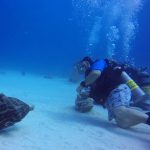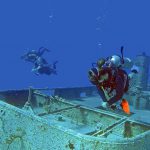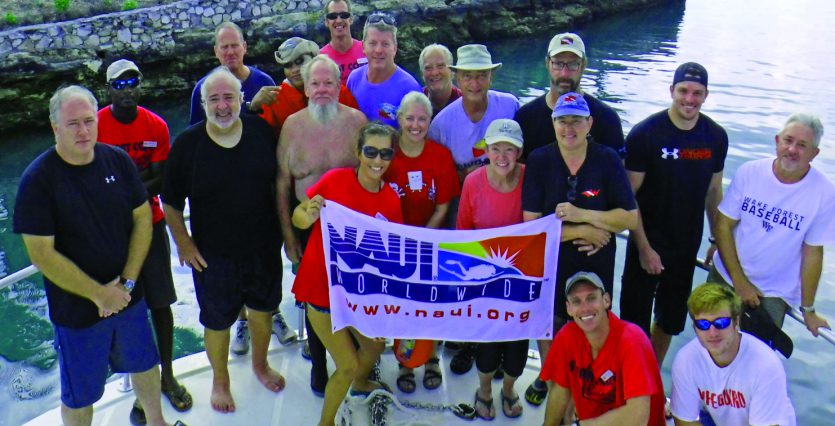One of my favorite movies is Caddyshack. Ty Cobb (Chevy Chase) gives Danny the “be the ball” advice. This is how I feel about the ocean. I dive in warm water in a Lycra suit so that I can feel the water, “be the water.” When I can actually feel the water, I am one with the water. I have not donned a wetsuit in over 30 years — my “Rule of 80 Degrees,” and I am not alone. Training in wetsuits is not required for NAUI Scuba Diver, Advanced or Master. Mine is also a plan that can help you make additional money.
A good friend of mine, a respected member of the dive industry, told me several years ago that she felt the industry was placing too much emphasis on technical and deep diving. It was forgetting about the divers and potential divers who just want to travel and dive warm locations at shallow and medium depths, where all of the color and most of the marine life is located. She said these people “just wanted to ski the bunny slopes.” Her analogy stuck with me. The ski industry has made a fortune catering to “bunny slopers.” I cannot understand why so much of the dive industry does not grasp this concept.

I have been a NAUI Instructor for 45-plus years, and I only teach warm water diving. I do my open water training in a quarry during the summer, with fair visibility, but we do not go below the thermocline. My students are certified in fresh water with beach entries, diving to 9 meters (30 feet), no currents and no wetsuits. They do, however, get extensive training in the pool on boat procedures and dive ladders. Buoyancy control, proper weighting and hovering skills are fine-tuned in the pool and the quarry. Weighting change for ocean diving is emphasized in class. Hovering beside an airplane at 5.5 meters (18 feet) is accomplished in the quarry. Ascents and descents while maintaining contact with the line are practiced. There is no current in the quarry, but they must understand ocean currents. I am preparing my divers to travel to the islands to dive the waters they have dreamed about.

During the course and after they are certified, I entice them to take an affordable trip with me to the Bahamas to continue their training and earn a NAUI Advanced Scuba Diver certification, as well as encourage them to begin working toward NAUI Master Scuba Diver. I always make a five-day trip that has three days of diving. The package includes a night dive for the Advanced course. As part of the arrangement, DAN members get a free afternoon dive. It allows for at least nine dives on the trip. I also include unlimited nitrox, which my divers appreciate. I encourage divers to do underwater imaging as one of their Advanced course dives and to take Underwater Digital Imaging as a specialty course. Affordable, simple underwater cameras with internal controls for color correction and HK video make this even easier. Doing the imaging specialty is a bit self-serving because the pictures they bring back and show will bring referrals.
- On last October’s trip to the Bahamas, Tim Stelma from Divin’ Dawgs in New Bern, North Carolina, and I had a mix ranging from three newly certified divers up to two NAUI Divemaster candidates. The newly certified bought full sets of equipment for the trip. Our new divers finished requirements for NAUI Advanced Scuba Diver and logged some Master dives. We did some digital imaging, and one of my students, Stephanie Richardson, had video of the Shark Adventure Dive posted on YouTube three days after we got home. One diver who was working on Master Scuba Diver now wants to work with me to become a NAUI Instructor. Everybody had a great time, and equipment and NAUI materials were sold. This is why I run Bahamas dive trips for clients.
Clients are to be developed and nurtured. Happy clients will bring you referrals. When I am in the Bahamas, I see a lot of cruise ship divers. Their cruise line diving costs a lot more than diving with you or me. They are rushed, and they get no choice of dive sites. You can offer trips that give your clients a much better experience, and you make money.

Several equipment manufacturers have gear designed to pack easily for air travel. Cressi’s Travelight BC, for example, packs small and dives well. Often two sets of this type of gear can be packed in one checked bag, keeping travel costs lower. Affordable, versatile cameras, such as the just introduced SeaLife ReefMaster, are expandable and do still and video at the touch of a button. Vivid-Pix, a sponsor of the Green Diver Initiative, has truly remarkable low-cost software that improves photos. Your clients’ digital images are a valuable source of free advertising for your center. Divers love to show their friends and family their underwater world.
A warm water scuba training program should use the NAUI Dual Certification Scuba/Nitrox Diver, and the pool training should emphasize the skills needed for ocean boat diving. Some viable open water training options are:
- Do your open water dives in the summer if you have a local warm water area with reasonable visibility. Then, entice them to go with you on your next affordable Caribbean or warm water trip to take your NAUI Advanced Scuba Diver course.
- If you take your students on an open water certification trip to a NAUI Dive Destination in the Caribbean, you would be surprised that airfares from the West Coast, Midwest and East Coast are about the same.
- Send your students to a NAUI Dive Destination “in the islands” with the Universal Referral Program (URP) to have their open water dives completed there. The old mindset that NAUI cannot have affiliates in the islands because they will convert NAUI referrals to other training agency certifications is being changed. Jack Snively, NAUI Director of Business Development, has ended this mindset, and NAUI is on the move with new NAUI Dive Destination affiliates in several Caribbean locations. They have agreed to conduct the URP to NAUI standards and sign the paperwork for the student to bring back to you to issue the certification. They will let your student dive temporary certification for the rest of their trip. You book the trip to the NAUI affiliate destination and coordinate with them that your students are coming. Do not just fill out the URP form and give it to your students. Be involved in the whole process. These are your clients. Do not charge them an extra fee for doing the URP packet; if you book the destination, you will make a commission. Your service will bring returns.
I have a very close working relationship with Stuart Cove’s Dive Bahamas, and I am their representative for NAUI Dive Centers and Instructors. I worked with Stuart personally, and we developed a special package for NAUI Instructors using the NAUI Scuba/Nitrox Dual Education System. The dive package compensation ratio is four paid and one free, instead of the normal seven-to-one ratio. If you are interested in this program and would like more information, please contact me at bahamasscuba@gmail.com.
As you teach, keep reminding your students about the wonderful warm, clear water that you will open to them. Help them visualize the majesty of a wall dive, the colorful coral reefs and the amazing marine life that they can personally experience. Sell the dream, and you will sell them continuing education and the necessary equipment that will turn them into confident, lifelong divers.


